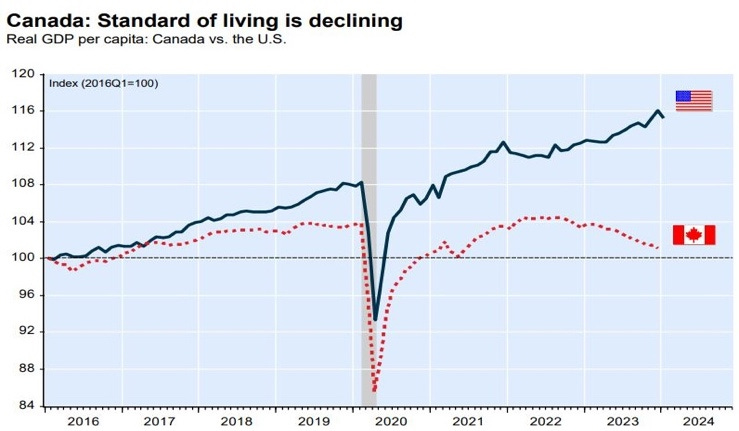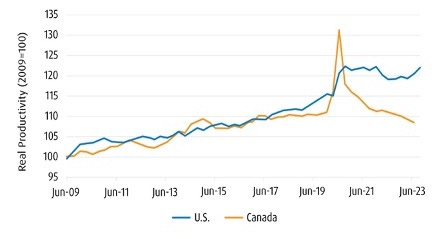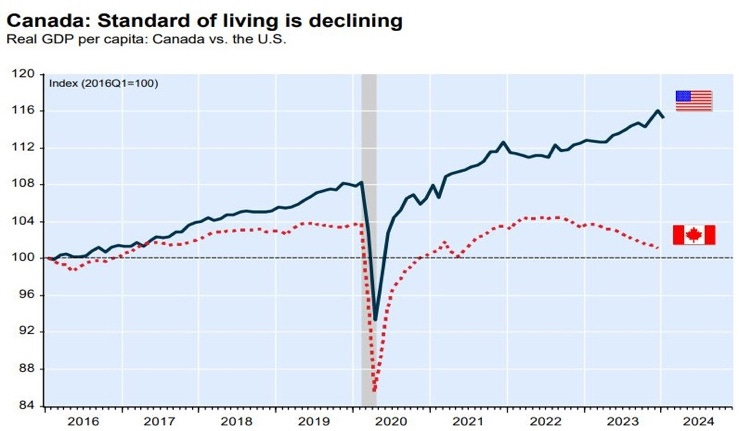Crisis on Crisis/Crisi su Crisi
Trump’s Tariffs Are Not the Only Issue in Canadian Economy/I dazi di Trump non sono l’unico problema dell’economia canadese (il testo in italiano segue quello in inglese)
Trump's tariffs are straining Canada's already fragile economy, widening the gap with the U.S. and sparking fears of the toughest post-war era yet
Trump will be blamed, and he deserves it. But the tariffs that the erratic resident of the White House has imposed on Canada (for now limited to 10% for energy and potash and 25% for steel and aluminum) will further worsen a situation that was already precarious to say the least. Now that the smokescreen of “Sunny Days” and the “post-national state” (copyright Trudeau) has faded, what remains are the numbers of Canada's economic situation, which, when compounded by the Trump effect, clearly give an idea of why the period ahead of Canada could be the most difficult since the post-war period. Before reviewing the data, the premise is that every time the gap in economic performance between two neighboring countries widens, the country that lags behind risks entering a negative spiral – “crowding out” of direct foreign investment, “brain drain” and pressure on domestic wages, just to give a few examples – from which it becomes very difficult to escape. Then if the stronger of the two also begins to act like a bully...
The Great Divergence: Canada vs. U.S. by the Numbers
So, here are the figures: in 2024, Canada's real GDP per capita fell by 1.4%, following a 1.3% decline the previous year, as recorded by Statistics Canada. Translation: over the last two years, on average, the purchasing power of Canadians has decreased. Essentially, it has been a creeping recession, masked by the steady increase in population through immigration, which has prevented a contraction of the total GDP, and by the repeated cuts in interest rates by the Bank of Canada, which gave oxygen to consumption, which in fact in the last quarter of 2024 experienced a rebound (+1.4%) after having fallen in 6 of the last 8 four-month periods (StatCan). The dead cat bounce, one might say, if irony weren't inappropriate.
If these figures are in themselves discouraging, they become alarming when compared to what has happened “south of the border”. Suffice it to mention one figure: real GDP per capita (calculated in 2015 dollars) in the U.S. is now $66,300 compared to $44,400 in Canada. (The Hub). Table No. 1 shows the progression of the gap, which was almost non-existent in 2017. It is no coincidence that the lines of per capita GDP follow in an almost specular way (net of the exceptional Covid period 2020-2021) the divergence in the trend of productivity in the two contexts (Table No. 2). As Paul Krugman, Nobel Prize winner for economics, points out:
“Productivity isn't everything, but in the long run it is almost everything. A country's ability to improve its standard of living over time depends almost entirely on its ability to increase output per worker.” – Krugman, The Age of Diminished Expectations, MIT Press
Table No. 1
Source: NBF Economics & Strategy (data via Statistics Canada and BEA)
Table No. 2
Source: Haver Analytics, BMO GAM.
There are other economic reasons for the decoupling (in the period 2007-2024 investments in Canada remained unchanged, in the USA they doubled) but, ultimately, the fact is that, on average, the standard of living of an American today is 50% higher than that of a Canadian.
An ominous warning
Sure, one could say that material availability isn't everything, that living in a society with Canadian values is a whole other thing compared to spending one's life in that merciless steamroller that is American society. But if the aim is to understand what kind of future is emerging for the country, also in light of the effects of Trump's tariffs (the USA is the destination of 75% of Canadian exports), and thus to come up with an action plan, it's best to start with a snapshot of the actual reality. And the reality is that Canada's economic situation, which has long been shrouded in a kind of complacency, was seriously deteriorating well before Trump's arrival. While President Trump's policies may ultimately damage the U.S. economy, Canada's will suffer more. This brings ominous resonance to historian Michael Bliss's prophecy in his seminal work on Canadian business history, Northern Enterprise:
“The one sure prescription for the eventual failure of the Canadian experiment would be to create an ever-widening gap in standards of living between the two North American democracies.”
That is why, quite rightly, there is now talk of an “existential threat.”
Crisi su crisi
I dazi di Trump non sono l’unico problema dell’economia canadese
I dazi imposti da Trump stanno destabilizzando un'economia canadese già precaria, acuendo il divario con gli Stati Uniti e prospettando quello che potrebbe rivelarsi il periodo più critico del secondo dopoguerra
Si darà la colpa a Trump, e se la merita. Ma le tariffe che l’imprevedibile inquilino della Casa Bianca ha imposto al Canada (per ora limitate al 10% per energia e fertilizzanti e al 25% per acciaio e alluminio) vanno a peggiorare una situazione che era di per sé a dir poco precaria. Ora che la cortina fumogena dei “Sunny Days” e dello “Stato post-nazionale” (copyright di Trudeau) si è alzata, quello che rimane sono i numeri della situazione economica del Canada, che, aggravati dall’effetto Trump, danno chiaramente l’idea del perché il periodo che si para dinanzi al Canada potrebbe essere il più difficile dal dopoguerra a oggi. Prima di passarli in rassegna, è utile ricordare che ogni volta che la forbice della performance economica fra due paesi vicini si allarga, il paese che resta indietro rischia di entrare in una spirale negativa – ‘spiazzamento’ negli investimenti dall’estero, ‘brain drain’ (fuga dei cervelli) e pressione sui salari interni, giusto per fare degli esempi – da cui uscire diventa difficilissimo. Se poi il più forte dei due si mette anche a fare il bullo...
Il grande divario: Canada vs. USA in cifre
Ed eccoli i numeri: nel 2024, il Pil reale pro capite canadese è sceso dell’1,4%, dopo esser calato dell’1,3% nell’anno precedente, come registrato da Statistics Canada (StatCan). Traduzione: sono due anni che in media, con tutti i limiti che le medie hanno, un canadese ha visto il suo potere d’acquisto peggiorare. In pratica, una recessione strisciante, occultata dal costante aumento della popolazione attraverso l’immigrazione, che ha evitato la contrazione del Pin totale, e dal ripetuto taglio dei tassi d’interesse da parte della Bank of Canada, che ha dato ossigeno ai consumi, i quali infatti nell’ultimo quadrimestre 2004 sono cresciuti (+1,4%) dopo esser scesi in 6 degli ultimi 8 quadrimestri. Il rimbalzo del gatto morto, si potrebbe dire, se l’ironia non fosse fuori luogo.
Se questi dati sono di per sé sconfortanti, diventano allarmanti se comparati a quanto è avvenuto “south of the border”. Basti un dato: Il Pil reale pro capite (calcolato in dollari 2015) negli Stati Uniti è oggi pari a 66.300 dollari contro i 44.400 dollari del Canada (The Hub). Il Grafico 1 mostra la progressione del divario, inesistente nel 2017. Non è un caso che le linee del Pil pro capite seguano in modo quasi speculare (al netto dell’eccezionalità del periodo Covid 2020-2021) la divergenza nell’andamento della produttività nei due contesti (Grafico 2). Come ha avuto modo di far notare Paul Krugman, premio Nobel per l’economia:
“La produttività non è tutto, ma a lungo andare è quasi tutto. La capacità di un paese di migliorare il proprio tenore di vita nel tempo dipende quasi interamente dalla sua capacità di aumentare la produzione per lavoratore.” – Krugman, The Age of Diminished Expectations, MIT Press
Grafico 1
Fonte: NBF Economics & Strategy (data via Statistics Canada and BEA)
Grafico 2
Fonte: Haver Analytics, BMO GAM.
Ci sono altri parametri economici che spiegano il decoupling (nel periodo 2007-2024 gli investimenti in Canada sono rimasti allo stesso livello, negli Usa sono raddoppiati) ma, in ultima analisi, resta il fatto che, mediamente, un americano ha oggi uno standard di vita del 50 percento superiore a quello di un canadese.
Un avvertimento sinistro
Certo, si può dire che le disponibilità materiali non sono tutto, che vivere in una società con i valori canadesi è tutt’altra cosa rispetto al passare la vita in quel rullo compressore impietoso che è la società statunitense. Ma se lo scopo è capire quale futuro si sta delineando per il paese, anche alla luce degli effetti delle tariffe di Trump (gli Usa sono la destinazione del 75% dell’export canadese), e quindi immaginare un piano d’azione, è opportuno partire da una fotografia della realtà. E la realtà è che la situazione economica del Canada, avvolta da lungo tempo in una sorta di autocompiacimento, si stava deteriorando seriamente ben prima dell’arrivo di Trump. Per quanto le iniziative dell’inquilino della Casa Bianca finiranno per far male alla stessa economia americana, quella canadese ne soffrirà comunque di più. Risuona così oltremodo minaccioso l’avvertimento dello storico Michael Bliss nel suo saggio sulla storia del business canadese, Northern Enterprise: “L'unica ricetta sicura per il fallimento finale dell'esperimento canadese sarebbe creare un divario sempre più ampio nel tenore di vita tra le due democrazie nordamericane.”
Ecco perché, giustamente, qui ora si parla di ‘minaccia esistenziale’.













I didn't know there existed such a place! :-)
I learned a lot from even this one newsletter. Thank you.